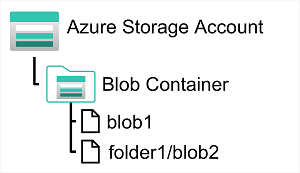Azure Blob Storage is a service that enables you to store massive amounts of unstructured data as binary large objects, or blobs, in the cloud. Blobs are an efficient way to store data files in a format that is optimized for cloud-based storage, and applications can read and write them by using the Azure blob storage API.
Azure Blob Storage supports three different types of blob:
- Block blobs. A block blob is handled as a set of blocks. Each block can vary in size, up to 4000 MiB. A block blob can contain up to 190.7 TiB (4000 MiB X 50,000 blocks), giving a maximum size of over 5000 MiB. The block is the smallest amount of data that can be read or written as an individual unit. Block blobs are best used to store discrete, large, binary objects that change infrequently.
- Page blobs. A page blob is organized as a collection of fixed size 512-byte pages. A page blob is optimized to support random read and write operations; you can fetch and store data for a single page if necessary. A page blob can hold up to 8 TB of data. Azure uses page blobs to implement virtual disk storage for virtual machines.
- Append blobs. An append blob is a block blob optimized to support append operations. You can only add blocks to the end of an append blob; updating or deleting existing blocks isn’t supported. Each block can vary in size, up to 4 MB. The maximum size of an append blob is just over 195 GB.
Blob storage provides three access tiers, which help to balance access latency and storage cost:
- The Hot tier is the default. You use this tier for blobs that are accessed frequently. The blob data is stored on high-performance media.
- The Cool tier has lower performance and incurs reduced storage charges compared to the Hot tier. Use the Cool tier for data that is accessed infrequently.
- The Archive tier provides the lowest storage cost, but with increased latency. The Archive tier is intended for historical data that mustn’t be lost, but is required only rarely. Blobs in the Archive tier are effectively stored in an offline state.
